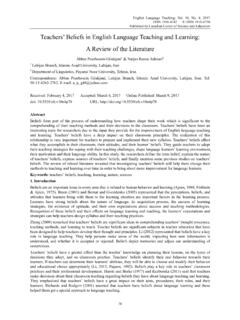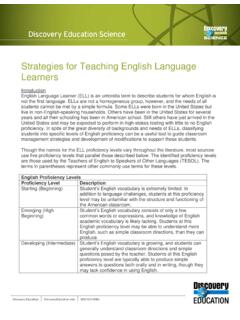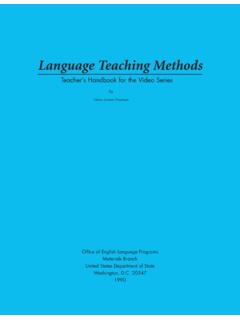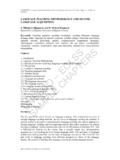Transcription of Task-Based Language Teaching - University of Alberta
1 Task-Based LanguageTeachingDavid NunanUniversity of Hong KongPUBLISHED BY THE PRESS SYNDICATE OF THE University OF CAMBRIDGEThe Pitt Building, Trumpington Street, Cambridge, United KingdomCAMBRIDGE University PRESSThe Edinburgh Building, Cambridge CB2 2RU, UK40 West 20th Street, New York, NY 10011-4211, USA477 Williamstown Road, Port Melbourne, VIC 3207, AustraliaRuiz de Alarc n 13, 28014 Madrid, SpainDock House, The Waterfront, Cape Town 8001, South Cambridge University Press 2004 This book is in copyright. Subject to statutory exceptionand to the provisions of relevant collective licensing agreements,no reproduction of any part may take place without thewritten permission of Cambridge University published 2004 Printed in the United Kingdom at the University Press, CambridgeTypeface9/11pt SabonSystemQuarkXPress A catalogue record for this book is available from the British LibraryLibrary of Congress Cataloguing in Publication dataISBN 0 521 84017 1 hardbackISBN 0 521 54947 7 paperbackContentsAcknowledgementsxiIntro ductionxiiiChapter 1 What is Task-Based Language Teaching ?
2 Introduction and overview1 Defining task 1 Broader curricular consideration4 Communicative Language teaching6 Alternative approaches to syllabus design10 Experiential learning12 Policy and practice13 The role of the learner14 Conclusion16 References16 Chapter 2 A framework for Task-Based Language teachingIntroduction and overview19A framework for Task-Based Language teaching19 Syllabus design considerations25 Developing units of work31 Seven principles for Task-Based Language teaching35 Conclusion38 References38 Chapter 3 Task componentsIntroduction and overview40 Goals41 Input47 Procedures52 Task types56 Teacher and learner roles64 Settings70 Conclusion73 References73viiChapter 4 An empirical basis for Task-Based languageteachingIntroduction and overview76 Early psycholinguistic models76 Interaction, output and the negotiation of meaning79 Task difficulty85 Conclusion90 References91 Chapter 5 Focus on form in Task-Based Language teachingIntroduction and overview93 Theoretical and empirical issues93 Focused versus unfocused tasks94 Consciousness-raising tasks98 Procedural language100 The place of a focus on form in an instructionalsequence101 Focus on form in the communicative classroom103 Conclusion111 References112 Chapter 6 Grading.
3 Sequencing and integrating tasksIntroduction and overview113 Grading input114 Learner factors118 Procedural factors122 Task continuity125 Within-task sequencing: the information gap128 Topic-based / theme-based instruction131 Content-based instruction131 Project-based instruction133 Conclusion135 References136 Chapter 7 Assessing Task-Based Language teachingIntroduction and overview138 Key concepts in assessment138 The purposes of assessment147 Self-assessment149 Techniques for collecting assessment data153 Criteria for assessing learner performance161 Conclusion164 References164viiiContentsChapter 8 Tasks and teacher developmentIntroduction and overview166 The self-directed teacher166An in-service workshop168 Evaluating tasks173 Creating tasks175 Conclusion177 Postscript177 References179 Appendix A
4 Approaches and methods an overview181 Appendix B A unit of work based on the six-step procedurepresented in Chapter 2187 Appendix C A unit of work based on the task/exercise typologyin Chapter 5195 Appendix D Graded activities for the four macroskills202 Appendix E Common reference levels: self-assessmentgrid210 Glossary212 Index218ixContents1 What is Task-Based Language Teaching ?Introduction and overviewThe concept of task has become an important element in syllabusdesign, classroom Teaching and learner assessment. It underpins severalsignificant research agendas, and it has influenced educational policy-making in both ESL and EFL , Task-Based Language Teaching has strengthened the fol-lowing principles and practices: A needs-based approach to content selection.
5 An emphasis on learning to communicate through interaction in thetarget Language . The introduction of authentic texts into the learning situation. The provision of opportunities for learners to focus not only on lan-guage but also on the learning process itself. An enhancement of the learner s own personal experiences as impor-tant contributing elements to classroom learning . The linking of classroom Language learning with Language use outsidethe this chapter, I will map out the terrain for the rest of the book. I willfirstly define task and illustrate the ways in which it will be used. I willthen relate it to communicative Language Teaching and set it within abroader curriculum framework, as well as spelling out the assumptionsabout pedagogy drawn on by the concept.
6 In the final part of the chapterI will look at the impact of the concept on the learner, on one hand, andon institutional policy and practice on the task Before doing anything else, I need to define the central concept behindthis book. In doing so, I will draw a basic distinction between what I willcall real-world or target tasks, and pedagogical tasks: target tasks, as thename implies, refer to uses of Language in the world beyond the class-room; pedagogical tasks are those that occur in the (1985: 89) frames his approach to Task-Based Language teachingin terms of target tasks, arguing that a target task is:a piece of work undertaken for oneself or for others, freely or forsome reward.
7 Thus examples of tasks include painting a fence,dressing a child, filling out a form, buying a pair of shoes, makingan airline reservation, borrowing a library book, taking a drivingtest, typing a letter, weighing a patient, sorting letters, making ahotel reservation, writing a cheque, finding a street destination andhelping someone across a road. In other words, by task is meantthe hundred and one things people do in everyday life, at work, atplay and in first thing to notice about this definition is that it is non-technicaland non-linguistic. It describes the sorts of things that the person in thestreet would say if asked what they were doing.
8 (In the same way aslearners, if asked why they are attending a Spanish course, are morelikely to say, So I can make hotel reservations and buy food when I m inMexico, than So I can master the subjunctive. ) Related to this is thenotion that, in contrast with most classroom Language exercises, taskshave a non-linguistic outcome. Non-linguistic outcomes from Long s listabove might include a painted fence, possession however temporary of a book, a driver s licence, a room in a hotel, etc. Another thing tonotice is that some of the examples provided may not involve languageuse at all (it is possible to paint a fence without talking).
9 Finally, individ-ual tasks may be part of a larger sequence of tasks; for example the taskof weighing a patient may be a sub-component of the task giving amedical examination .When they are transformed from the real world to the classroom, tasksbecome pedagogical in nature. Here is a definition of a pedagogical task:.. an activity or action which is carried out as the result ofprocessing or understanding Language ( as a response). Forexample, drawing a map while listening to a tape, listening to aninstruction and performing a command may be referred to astasks. Tasks may or may not involve the production of Language . Atask usually requires the teacher to specify what will be regardedas successful completion of the task.
10 The use of a variety ofdifferent kinds of tasks in Language Teaching is said to makelanguage Teaching more communicative .. since it provides apurpose for a classroom activity which goes beyond the practice oflanguage for its own sake.(Richards,et : 289)In this definition, we can see that the authors take a pedagogical perspec-tive. Tasks are defined in terms of what the learners will do in class rather2 What is Task-Based Language Teaching ?than in the world outside the classroom. They also emphasize the impor-tance of having a non-linguistic (1987: 23) offers another definition of a pedagogical task:.. any structured Language learning endeavour which has aparticular objective, appropriate content, a specified workingprocedure, and a range of outcomes for those who undertake thetask.









